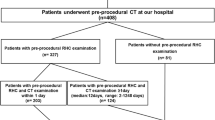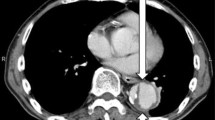Abstract
Purpose
The purpose of this study was to report a new computed tomography (CT) finding in acute cardiac tamponade: a contrast-fluid level in the hepatic inferior vena cava (IVC) during an arterial dominant phase CT study (IVC niveau sign) in patients with acute type A aortic dissection.
Materials and methods
We retrospectively reviewed CT studies with the diagnosis of proximal aortic dissection (Stanford type A) with acute cardiac tamponade. There were 12 patients enrolled in the study (6 women, 6 men; mean age 66 years). A total of 62 patients were selected as a control chronic pericardial effusion group to compare with the acute cardiac tamponade group.
Results
Among the 12 patients with acute cardiac tamponade, the IVC niveau sign was seen in 7 (58%). In the control chronic pericardial effusion group (n = 62), we identified the IVC niveau sign in only one patient (1.6%). There was a significant difference in the presence of the IVC niveau sign between the acute cardiac tamponade and chronic pericardial effusion groups (P < 0.0001).
Conclusion
The presence of the IVC niveau sign suggests acute cardiac tamponade in patients with acute type A aortic dissection.
Similar content being viewed by others
References
Yoshida S, Akiba H, Tamakawa M, Yama N, Hareyama M, Moshita K, et al. Thoracic involvement of type A aortic dissection and intramural hematoma: diagnostic accuracy—comparison of emergency helical CT and surgical findings. Radiology 2003;228:430–435.
Chong HH, Plotnik GD. Pericardial effusion and tamponade: evaluation, imaging modalities, and management. Compr Ther 1995;21:378–385.
Harries SR, Fox BM, Roobottom CA. Azygos reflux: a CT sign of cardiac tamponade. Clin Radiol 1998;53:702–704.
Hernandez-Luyando L, Calvo J, Gonzalez de las Heras E, de la Puente H, López C. Tension pericardial collections: sign of “flattened heart” in CT. Eur J Radiol 1996;23:250–252.
Gold MM, Spindola-Franco H, Jain VR, Spevack DM, Haramati LB. Coronary sinus compression: an early computed tomographic sign of cardiac tamponade. J Comput Assist Tomogr 2008;32:72–77.
Restrepo CS, Lemos DF, Lemos JA, Velasquez E, Diethelm L, Ovella TA, et al. Imaging findings in cardiac tamponade with emphasis on CT. Radiographics 2007;27:1595–1610.
Braunwald E, Zipes DP, Libby P. Heart disease. 6th edition. Philadelphia: Saunders; 2001. p. 1838–1848.
Braunwald E. Harrison’s principle of internal medicine. 15th edition. New York: McGraw-Hill; 2001. p. 1365–1368.
Duddy MJ. Venous reflux in body computed tomography. Clin Radiol 1999;54:340.
Author information
Authors and Affiliations
Corresponding author
About this article
Cite this article
Sueyoshi, E., Imamura, T., Sakamoto, I. et al. Contrast-fluid level in the inferior vena cava (IVC niveau sign) in patients with acute type A aortic dissection: computed tomography findings during acute cardiac tamponade. Jpn J Radiol 28, 278–282 (2010). https://doi.org/10.1007/s11604-010-0422-4
Received:
Accepted:
Published:
Issue Date:
DOI: https://doi.org/10.1007/s11604-010-0422-4




